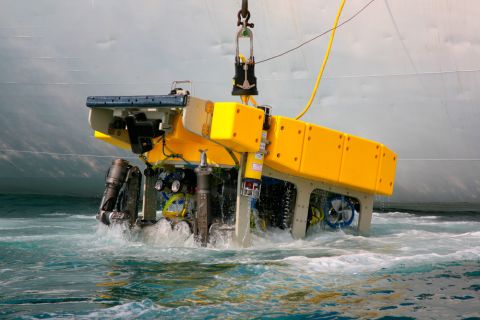Intelligent management system reduces false alarms from erosion probes
The Roxar Fieldwatch 3.0 production management system by Emerson Process Management provides engineers with important operational data to improve decision-making during production optimization operations. The new intelligent reservoir management features help reduce the number of false alarms that can occur in sand erosion control, the company said. The latest version includes smart alarm software that features a new filtering and temperature compensation algorithm and signal stability as well as trend analysis software that can identify unconformities, including changes in temperature, production regimes, and electromagnetic interference, helping to mitigate false alarms. Results from testing the smart alarm software on historical data from a North Sea field showed the suppression of 99% of false alarms while 100% of the genuine alarms were retained, Emerson said. Emersonprocess.com.

Roxar Fieldwatch collects, monitors, visualizes, and analyzes reservoir data and incorporates a series of custom-built modules in the areas of flow assurance, sand and erosion, corrosion, and virtual flow metering. (Image courtesy of Emerson Process Management)
Reservoir characterization services maximize HP/HT operations
The next generation of the Baker Hughes Reservoir Characterization eXplorer (RCX) and In-situ Fluids eXplorer (IFX) formation testing services can characterize fluid properties in real time and can be deployed in challenging HP/HT wells to provide mission-critical information during the well construction process. Compatible with the Baker Hughes multitank carrier model to reduce risk and rig time, the RCX service gathers data and fluid samples to 27,000 psi and 201°C (395°F). It also features high-capacity pumps that can improve operations in highly overbalanced wells. The IFX service is designed primarily for deepwater and high-temperature wells to characterize downhole fluid compositions in real time, optimizing fluid identification and sample collection and providing input into the petrophysical evaluations for early assessments of reservoir value. A tuning fork sensor and separate sound speed transducer also provides high-resolution density, viscosity, and sound speed information. The resulting data allows direct calculation of a continuous gas-oil ratio without reference to any offset information, the company said. Bakerhughes.com.

The next generation of Reservoir Characterization eXplorer acquires accurate pressure data and samples in HP/HT environments. (Image courtesy of Baker Hughes)
Advanced NDT systems increase pipeline, platform defect detection
Applus RTD has designed two new products to locate defects in pipelines, oil and gas platforms, and other infrastructure using advanced digital radiography. The RTD Rayscan device is suited for both onshore and offshore pipeline inspection work, including the inspection of girth welds on lay barges and onshore new construction projects, the company said.
The system uses a small, collimated X-ray beam, short exposure, and lower energy levels than conventional techniques, to mitigate radiation hazards. Its X-ray source and detector rotate around the exterior of the weld, producing a real-time digital radiographic double wall single image (DWSI) picture. According to the company, direct image processing also makes it possible for direct interpretation of the weld, allowing easier defect identification and recording.
Additionally, the Applus IWEX 3D (inverse wave field extrapolation) technique provides a reconstructed image of the inspected object shown in real time using automated ultrasonic testing and complex algorithms that can increase the accuracy of defect size, position, and probability. Applusrtd.com. Frequency decomposition tool enhances seismic data images
A new technology introduced by ffA combines volumetric frequency decomposition and high-resolution RGB color blending to reveal previously inaccessible information on many aspects of imaged geology, such as pinch outs and thinly bedded reservoir units, that are critical to the technical and economic success of E&P projects. Using a proprietary adaptive technology, the HD Frequency Decomposition solution targets signal information from seismic data at any frequency to achieve the best possible resolution at every point in the trace, the company said. Moreover, its enhanced vertical resolution results can provide a better match with well data and also can give the precise vertical position of the most subtle geological features, improving both operator efficiency and workflow. ffa-geosciences.com.

The HD Frequency Decomposition’s enhanced vertical resolution can provide a better match between seismic and well data. (Image courtesy of Lundin Norway)
New intervention tool removes wellbore debris
The M-I Swaco Well Scavenger tool captures and removes relatively small amounts of debris from the wellbore during well intervention applications. The tool pumps driving fluid through the fluid jet pump, generating a reverse circulation flow from the bottom of the tool through the suction tube. Once the debris has been picked up, it settles in the debris basket as the fluid velocity decreases after passing through the flow diverter. The fluid then passes through the filter screen, which captures suspended materials. A reverse circulation path is created at the end of the workstring, allowing the system to pick up the debris and capture it in situ. The Well Scavenger tool can be combined with string magnets or junk baskets to increase the removal capabilities for ferrous or larger debris. According to M-I Swaco, the tool’s optimum environment is with Newtonian fluids that have limited solids carrying capability or when open perforations, pressure-sensitive downhole hardware, or limitations from surface equipment make it impossible to use high pump rates and pressures. Miswaco.com/wellscavenger.

Drilling product line targets better ROP in high angle, horizontal wells
Three new Raptor drilling tools have been designed to enhance drilling performance in the latest generation of wells designs by delivering improved rate of penetration (ROP) in high angle and horizontal wells, according to provider Paradigm Oilfield Services. Flexible in its ability to ream and back-ream, the Raptor Reamer uses a fully supported cam-arm expansion method and fail-safe closure mechanism to streamline operations. Meanwhile, the Raptor Tractor reduces torque as well as the potential for stick and slip while drilling and features a collar that provides 20% of its own weight in forward thrust to ensure consistent weight on bit and improved ROP. The third new tool, Raptor Roller, includes a latch/lock roller retention mechanism that offers total security, according to Paradigm, with rolling elements further reducing formation stress during drilling operations. The combination of the Raptor Roller’s pressure balanced grease lubrication system and optimized fluid by-pass also enhance performance in a range of hole conditions. Paradigmoilfield.com.
– Nancy Agin, Associate Editor
Recommended Reading
E&P Highlights: March 4, 2024
2024-03-04 - Here’s a roundup of the latest E&P headlines, including a reserves update and new contract awards.
Less Heisenberg Uncertainty with Appraisal Wells
2024-03-21 - Equinor proves Heisenberg in the North Sea holds 25 MMboe to 56 MMboe, and studies are underway for a potential fast-track tieback development.
E&P Highlights: March 15, 2024
2024-03-15 - Here’s a roundup of the latest E&P headlines, including a new discovery and offshore contract awards.
E&P Highlights: May 6, 2024
2024-05-06 - Here’s a roundup of the latest E&P headlines, including technology milestones and new contract awards.
SLB, OneSubsea, Subsea 7 Sign Collaboration Deal with Equinor
2024-05-02 - Work is expected to begin immediately on Equinor’s Wisting and Bay Du Nord projects.





